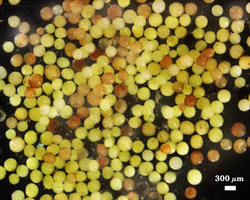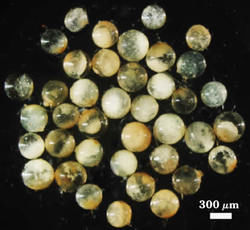Gigaspora gigantea
Preparing Clean Healthy Spores for Shipment
Extracted Population of Spores

After sucrose centrifugation and washing, a random sampling of spores was collected. In this particular population of extracted spores, a relatively high proportion are compromised in some way (of atypical morphology). The classes of spores manually removed are detailed below. Any departure from a vibrant healthy condition are easy to detect in Gi. gigantea because spore color is uniquely determined by pigments in the cytoplasm and changes in these pigments become apparent within 24 hr of extraction. In a “typical” culture, the percentage of “unhealthy” spores ranges from 5-20%. In cultures with high microbiota counts, 50-60% of the spores could be damaged in some way. Under those conditions, new cultures always are started from healthy spores (screened as described below).

Immature Spores
Young spores typically are salmon to dark pinkish-red in color, but the main distinguishing feature is opaque contents. Degraded spores will have a similar color range but contents are more translucent and patchy (see at right).

Spores with Atypical Contents
These spores are easy recognized by contents with varying degrees of patchiness in density and color. Note lack of any greenish tint. Inoculation of plants with these spores fails to produce any mycorrhizae.

Parasitized and Dead Spores
Spores lacking any contents are obviously dead. Most of these “husks” are residual propagules from the parent inoculum. Spores with spots, surface growth, or black contents usually are parasitized (saprophytic fungi mostly).
Healthy Spores

This population of healthy spores has shown little change over 24 hr after storage at 4oC, and therefore is considered ready for shipment in sterile sand or water. Some of these spores likely are going to degrade or senesce during shipment because of higher and nonuniform temperature conditions. Since they are beyond our capacity to monitor, it becomes essential that the user take time to examine spores after they are unpackaged and before any manipulation, document their condition, and remove any atypical spores. It also is important that INVAM receives input as to condition of received material so that we can learn more about the tolerance of these spores to shipping conditions and take steps to minimize problems.